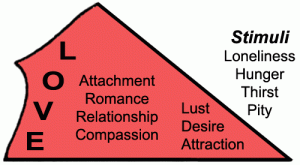Love
What is Love?
| Love 4:20 |
This page does not consider all the philosophical applications of the term love. The focus of Love, here, is its role in processing stimuli—in other words, the role of Love in feeling feelings.
Let’s consider a few of the common stimuli that arouse the emotion of Love and some of its relatives, such as desire, lust, nurturing, and compassion.
Using Love to Process Simple Stimuli
What stimuli are being processed by Love and its related feelings? Hunger and thirst are the most basic. They are simple sensations that move you to desire food and drink.
The food and drink you desire are the result of the way you use the emotion of desire. If you desire the pleasure of food, you will choose something tasty. If you desire the pleasure of physical fitness, you will choose something healthy. Your ability to eat healthy is rooted in the way you process very basic emotions in the Love section of the Balance Wheel.
More Complex Stimuli
Desire also governs the way you experience the emotion of lust. An attractive person stimulates lust. If you desire immediate sexual gratification, you will attempt to seduce the attractive person. If you desire a higher level of interpersonal relationship, you will seek this relationship either with the attractive person or with another person such as your mate.
What Stimulates Compassion?
Compassion is yet another response to the emotion of desire. Desire is a conscious response to a stimulus or to another emotion—in this case, pity. Pity (a form of Grief) is the emotion we feel for another person’s loss because it reminds us of our own loss. Pity also stimulates the desire to alleviate that person’s suffering. In chronological order then, pity arouses desire which arouses compassion. The “Love” pie piece below displays that chronological order along with several other progressions of emotion as the intensity of Love grows from the simple stimuli at the center point outward.
Compassion is the positive response to a negative stimulus such as pity, but there are other stimuli for it. Compassion also arises from the general desire to be selfless. Many cultures encourage the practice of selflessness. An example is the Golden Rule: “Do unto others as you would have them do unto you.” Regardless how ethical or altruistic compassion may seem, it nevertheless proceeds from the emotion of desire—desire to be compassionate.
Do not confuse compassion with nurturing. Nurturing is one of three innate responses that nearly all animals seem to experience when meeting another animal: (1) attack/flee, (2) mate/reject, and (3) nurture/be nurtured. These responses exist even in simpler animals that lack a pre-frontal cortex.
The Higher Purpose of Love
By now, it is plain that the most effective use of the entire section of Love on the Balance Wheel comes down to an effective application of the emotion called desire. If you are well along in your journey through life, the quality of Love that you have is the direct result of the things you desired along the way. If you are just beginning your adult life, the quality of Love that you seek will be the direct result of the things you desire.
Featured Video



{ 1 trackback }